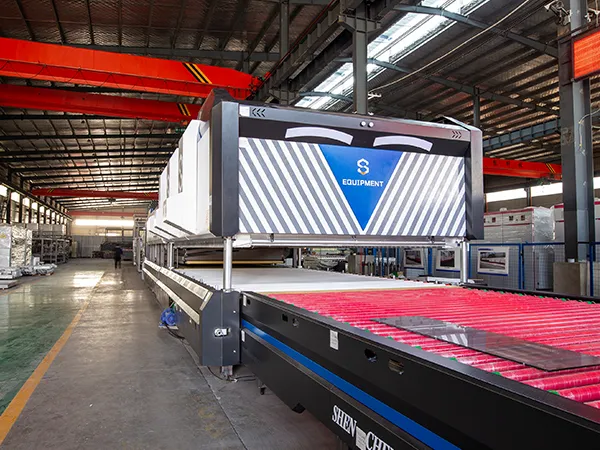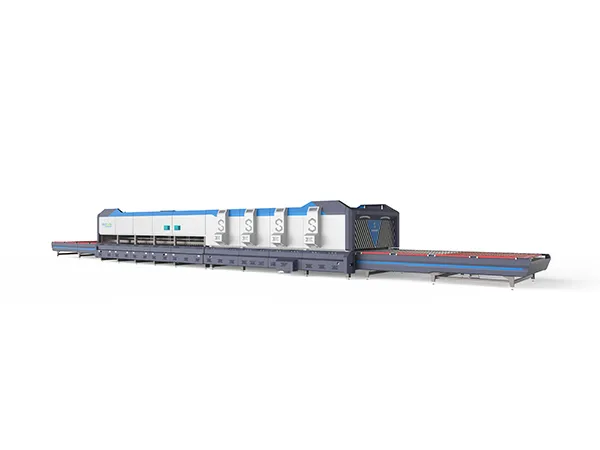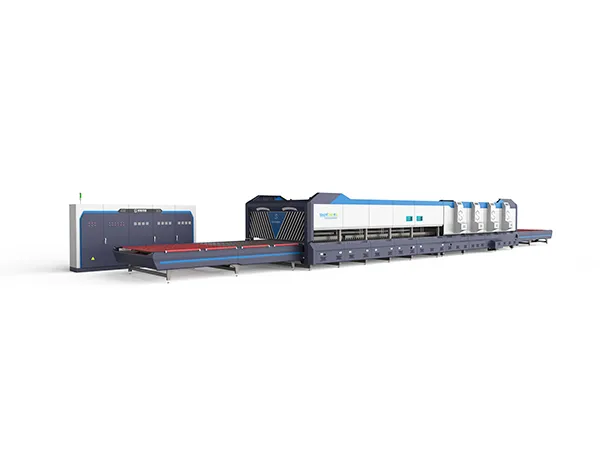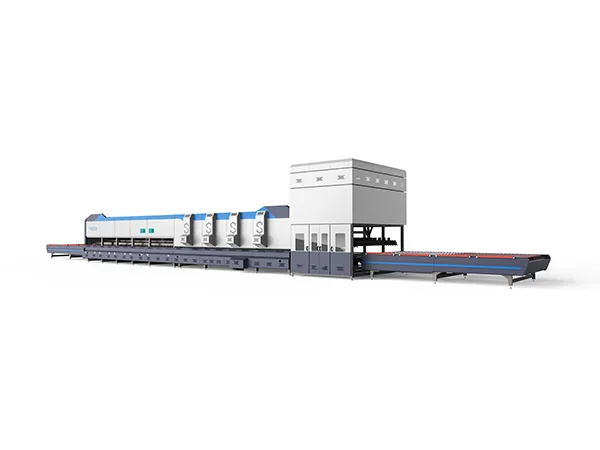Glass Tempering Furnaces Introduction
Glass tempering furnaces are essential in the glass manufacturing industry, enabling the production of tempered glass, which is significantly stronger than regular annealed glass. This article explores the technical aspects of glass tempering furnaces, including their design, operation, types, and maintenance.
Principles of Glass Tempering
Glass tempering involves heating glass to a temperature just below its melting point (approximately 600-650°C) and then rapidly cooling it. This process induces compressive stresses on the surface and tensile stresses inside, resulting in increased strength and improved safety characteristics. Tempered glass shatters into small, blunt pieces rather than sharp shards.
Components of a Glass Tempering Furnace

Heating Section
Heating Elements: Typically made from high-resistance alloys such as Kanthal (FeCrAl) or Nickel-Chromium (NiCr) alloys. These elements provide consistent and uniform heating.
Insulation: High-quality refractory materials like ceramic fiber boards or alumina-silicate bricks are used to insulate the furnace, reducing heat loss and improving energy efficiency.
Temperature Control: Advanced control systems, often employing thermocouples and infrared sensors, ensure precise temperature regulation throughout the heating chamber.
Quenching Section
Air Blowers: Powerful fans generate high-pressure air streams for rapid cooling. The airflow must be uniform and controllable to achieve the desired stress profile in the glass.
Nozzles: Specially designed nozzles distribute air evenly across the glass surface. The nozzle arrangement and size are critical for achieving uniform cooling.
Conveyor System
Rollers: Heat-resistant rollers, often made from fused silica or ceramic-coated steel, transport the glass through the furnace. The roller speed is adjustable to control the heating and cooling rates.
Drive Mechanism: Precision motors and drives ensure smooth and consistent movement of glass through the furnace.
Types of Glass Tempering Furnaces
Horizontal Tempering Furnaces
Operation: Glass moves horizontally through the furnace on rollers.
Applications: Suitable for flat glass panels used in windows, doors, and automotive applications.
Advantages: Reduced risk of glass surface damage and higher throughput.
Vertical Tempering Furnaces
Operation: Glass is suspended vertically during the tempering process.
Applications: Used for thinner or specialty glass shapes, such as shower doors and architectural panels.
Advantages: Lower space requirements and ability to handle more complex shapes.

Technical Specifications
Maximum Glass Thickness: Typically ranges from 3mm to 19mm.
Cycle Time: Varies depending on glass thickness and furnace type, generally ranging from 2 to 5 minutes per sheet.
Heating Capacity: Furnaces can handle glass sizes from small panels to large sheets up to 3.3m x 6m.
Energy Consumption: Efficiency improvements are continually sought, with modern furnaces incorporating energy recovery systems to reduce consumption.
Operation and Control
Pre-Heating Phase
Loading: Glass sheets are loaded onto the conveyor system.
Initial Heating: The glass is gradually heated to avoid thermal shock.
Heating Phase
Uniform Heating: The temperature is raised to the tempering range (600-650°C), ensuring uniform heat distribution across the glass surface.
Temperature Monitoring: Continuous monitoring and adjustment maintain the desired temperature profile.
Quenching Phase
Rapid Cooling: The glass is quickly transferred to the quenching section, where high-pressure air cools it rapidly.
Stress Formation: Controlled cooling induces the necessary stress distribution for tempered glass.
Post-Quenching Phase
Unloading: Tempered glass is carefully removed from the conveyor system.
Inspection: Visual and automated inspections check for quality and stress uniformity.

Maintenance and Troubleshooting
Regular Maintenance
Heating Elements: Periodically inspect and replace worn heating elements to maintain consistent performance.
Insulation: Check and repair any damaged insulation to prevent heat loss.
Conveyor System: Lubricate and inspect rollers and drive mechanisms to ensure smooth operation.
Air Blowers and Nozzles: Clean and inspect to ensure uniform airflow during quenching.
Troubleshooting
Temperature Variations: Address issues with heating elements or control systems to maintain uniform temperature.
Airflow Inconsistencies: Ensure blowers and nozzles are functioning correctly to avoid uneven cooling and stress distribution.
Conclusion
Glass tempering furnaces are critical for producing high-strength, safety-enhanced glass. Understanding the technical specifications and operational considerations of these furnaces is essential for optimizing performance and ensuring product quality. Regular maintenance and precise control of the heating and quenching processes are vital to achieving the desired properties in tempered glass. As technology advances, glass tempering furnaces continue to evolve, offering improved efficiency, capacity, and control for the glass manufacturing industry.










